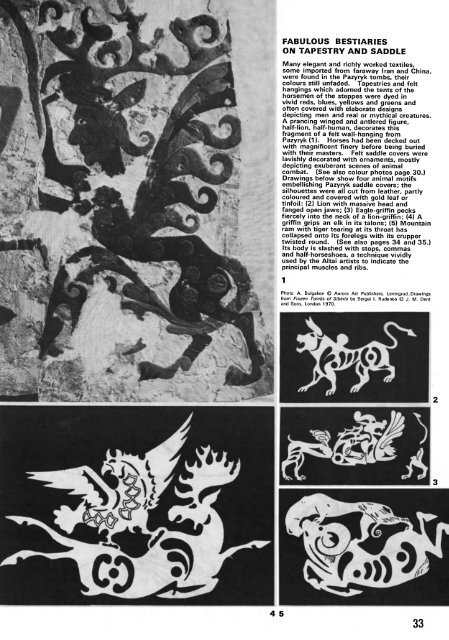The Scythians: nomad goldsmiths of the open steppes; The ...
The Scythians: nomad goldsmiths of the open steppes; The ...
The Scythians: nomad goldsmiths of the open steppes; The ...
You also want an ePaper? Increase the reach of your titles
YUMPU automatically turns print PDFs into web optimized ePapers that Google loves.
4 5<br />
FABULOUS BESTIARIES<br />
ON TAPESTRY AND SADDLE<br />
Many elegant and richly worked textiles,<br />
some imported from faraway Iran and China,<br />
were found in <strong>the</strong> Pazyryk tombs, <strong>the</strong>ir<br />
colours still unfaded. Tapestries and felt<br />
hangings which adorned <strong>the</strong> tents <strong>of</strong> <strong>the</strong><br />
horsemen <strong>of</strong> <strong>the</strong> <strong>steppes</strong> were dyed in<br />
vivid reds, blues, yellows and greens and<br />
<strong>of</strong>ten covered with elaborate designs<br />
depicting men and real or mythical creatures.<br />
A prancing winged and antlered figure,<br />
half-lion, half-human, decorates this<br />
fragment <strong>of</strong> a felt wall-hanging from<br />
Pazyryk (1). Horses had been decked out<br />
with magnificent finery before being buried<br />
with <strong>the</strong>ir masters. Felt saddle covers were<br />
lavishly decorated with ornaments, mostly<br />
depicting exuberant scenes <strong>of</strong> animal<br />
combat. (See also colour photos page 30.)<br />
Drawings below show four animal motifs<br />
embellishing Pazyryk saddle covers; <strong>the</strong><br />
silhouettes were all cut from lea<strong>the</strong>r, partly<br />
coloured and covered with gold leaf or<br />
tinfoil: (2) Lion with massive head and<br />
fanged <strong>open</strong> jaws; (3) Eagle-griffin pecks<br />
fiercely into <strong>the</strong> neck <strong>of</strong> a lion-griffin; (4) A<br />
griffin grips an elk in its talons; (5) Mountain<br />
ram with tiger tearing at its throat has<br />
collapsed onto its forelegs with its crupper<br />
twisted round. (See also pages 34 and 35.)<br />
Its body is slashed with stops, commas<br />
and half-horseshoes, a technique vividly<br />
used by <strong>the</strong> Altai artists to indicate <strong>the</strong><br />
principal muscles and ribs.<br />
Photo A. Bulgakov © Aurora Art Publishers. Leningrad . Drawings<br />
from Frozen Tombs <strong>of</strong> Siberia by Sergei I. Rudenko © J. M. Dent<br />
and Sons, London 1970.<br />
33

















